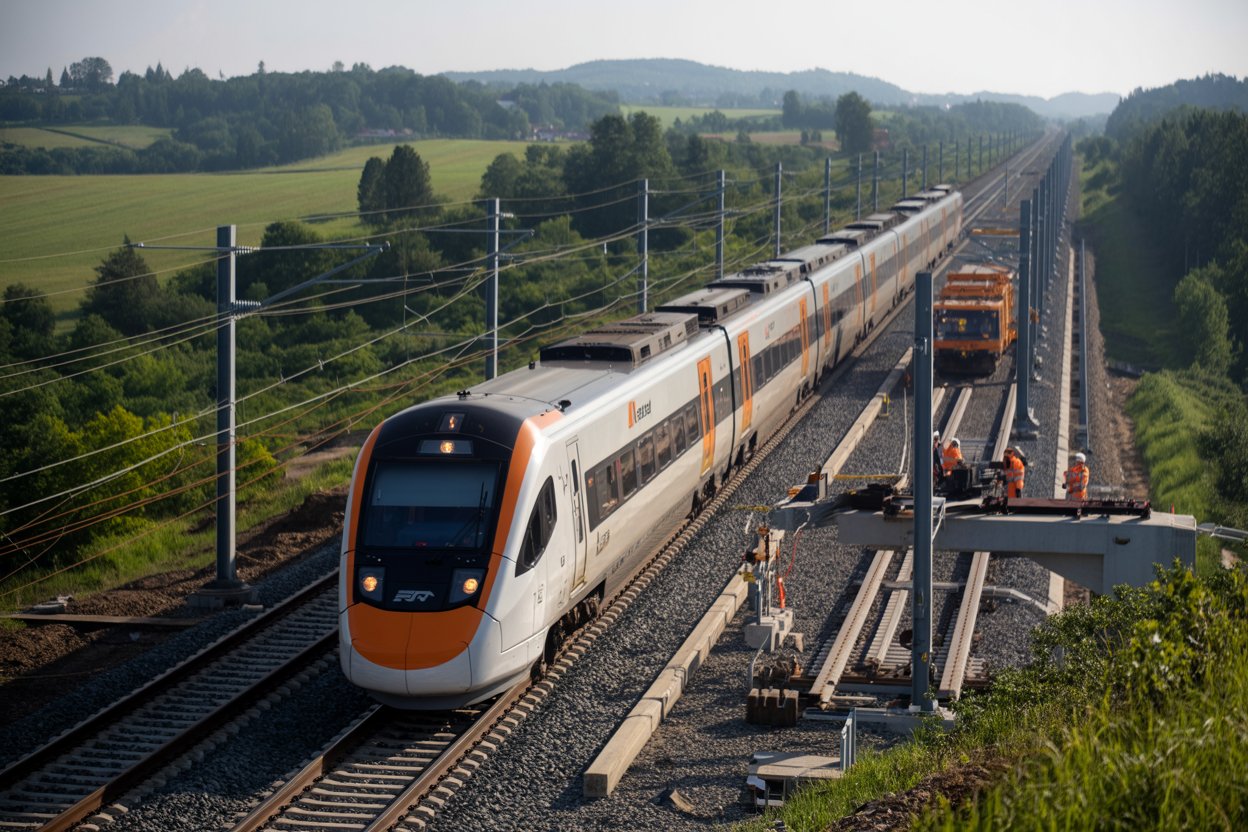Published on
October 8, 2025
RB Rail, the project delivery company responsible for overseeing the Rail Baltica development, has officially launched tracklaying operations on the new 1435mm-gauge railway line in Lithuania. The work is taking place in the Jonava district, with a focus on the 8.8km stretch between Šveicarija and Žeimiai. This section of the Rail Baltica network is expected to be completed by the end of this year, marking a major milestone in the project’s ambitious timeline.
The tracklaying process is being carried out by a joint venture between the German company Leonhard Weiss and its Estonian subsidiary, Leonhard Weiss OÜ. The joint venture secured the €13.9 million contract for this work earlier this year, which was awarded by Lithuania’s infrastructure manager, LTG Infra.
Tracklaying Materials and Process
The Lithuanian section of the Rail Baltica project requires a significant amount of materials to ensure the track is laid to the highest standards. LTG Infra has procured 86,200 tonnes of ballast, 29,500 reinforced concrete sleepers, and 42km of rail, which will be laid in 25-metre sections. These materials are crucial for the construction of the railway line, which will be an integral part of the Rail Baltica network, connecting the Baltics to the rest of Europe.
Egidijus Lazauskas, CEO of LTG, highlighted that while planning and design take up a substantial portion of the project’s timeline, the focus now is on maintaining the momentum from last year and progressing at a rapid pace. This acceleration in work is a critical part of ensuring that the project remains on schedule and that the benefits of the new rail link can be realised as soon as possible.
Significant Civil Works Across Lithuania
Beyond the Šveicarija – Žeimiai section, significant civil works are also taking place on the Kaunas – Panevėžys section of Rail Baltica. This stretch will involve the construction of embankments and other structural works, with 77km of embankment currently under development. By the end of this year, it is expected that 114km of Rail Baltica will be under construction across Lithuania, which includes ongoing tracklaying efforts and the construction of major structures such as the new bridge over the Neris River. This bridge is set to become the longest of its kind in Lithuania and is an important part of the infrastructure that will enable faster and more efficient rail travel in the future.
The progress of these works underscores the scale of the Rail Baltica project and the comprehensive approach being taken to develop the rail network in Lithuania. This project, in collaboration with other Rail Baltica partners across the Baltics, will transform regional transport and connectivity, providing a much-needed high-speed rail link between the Baltic states and Europe.
Developments in Estonia and Latvia
Rail Baltica’s expansion isn’t limited to Lithuania. In Estonia, civil works are currently underway on 105km of the planned route. Contracts have already been signed for an additional 200km of civil works and tracklaying, reflecting the project’s wide-reaching scope across the region. As part of the overall Rail Baltica vision, Estonia is set to become a key player in connecting the Baltic countries to the European rail network.
In Latvia, the project continues to advance, with work focusing on the southern section of the main line between Riga and the Lithuanian border. This section, part of the 202km of Rail Baltica that will run through Latvia, is a critical part of the network that will connect the Baltic region with Central and Western Europe.
RB Rail reports that by the end of this year, 43% of the Rail Baltica main line will be ready for construction. This milestone is a significant achievement in the development of the project and demonstrates the continued commitment to completing the line on time.
Enhancing Regional Connectivity
Once completed, Rail Baltica will provide a modern, high-speed rail link connecting the Baltic states to the wider European railway network. This will improve regional connectivity and offer a faster, more sustainable mode of transport for both passengers and goods. Rail Baltica is expected to have a transformative impact on the region, providing a much-needed alternative to road and air transport and helping to reduce congestion and emissions.
The rail project is expected to boost economic growth in the Baltic region by enhancing mobility, increasing trade, and fostering stronger regional connections. The project is being implemented in phases, with Lithuania, Latvia, and Estonia all making significant progress in the construction of their sections.
Conclusion: Rail Baltica’s Promising Future
The commencement of tracklaying on the Šveicarija – Žeimiai section is just one of many steps in the broader Rail Baltica project. With substantial progress already made in Lithuania and ongoing works in Estonia and Latvia, the rail network is set to become a game-changer for the region.
The successful completion of Rail Baltica will not only improve transport across the Baltic states but will also connect these countries with the rest of Europe, enhancing both economic and social ties. The project remains on track for completion in the coming years, with key milestones being met as scheduled, solidifying Rail Baltica’s place as a major infrastructure development in Europe.
